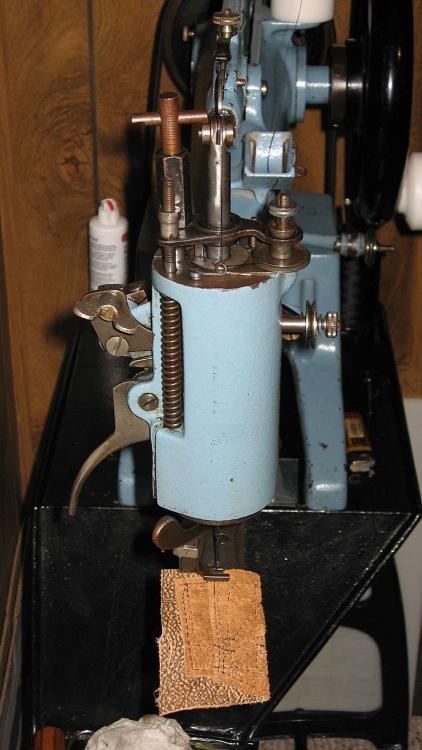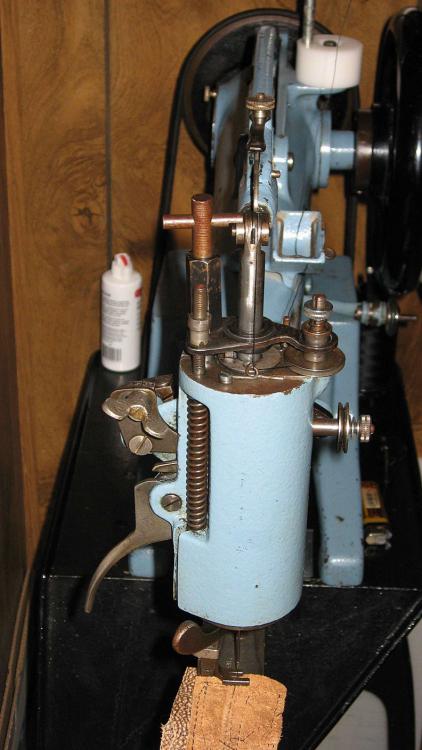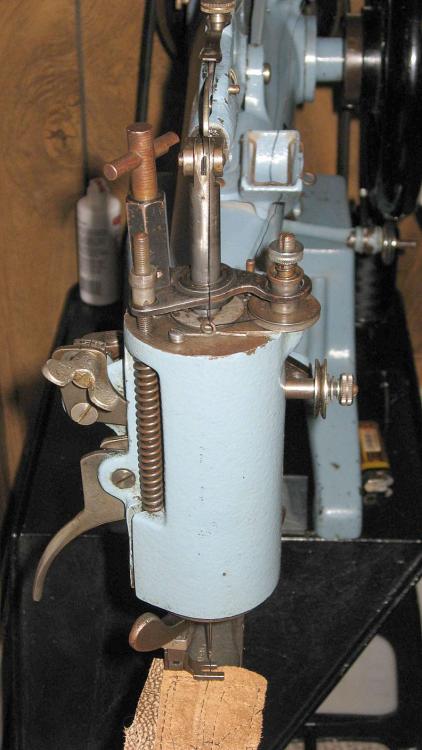-
Posts
7,773 -
Joined
-
Last visited
Content Type
Profiles
Forums
Events
Blogs
Gallery
Everything posted by Wizcrafts
-

Singer 111W153 & table resto project
Wizcrafts replied to Sugarkryptonite's topic in Leather Sewing Machines
That is one beautiful piece of work! Kudos! -
It is spring loaded and free turning. You just turn it to the desired position before it is hit by the needle bar. It can be mastered in about 5 standard Earth minutes.
-
I have a Fortuna skiver (date unknown) and a newer Singer 29k71 patcher. I have owned numerous patchers, all the way back to the 29-4 model from the turn of the 20th Century. Here is what I've found about your 51-28 (last one made in 1938), which says the recommended replacement was the 51-54, having these specs: Post bed; one-needle; rotary hook; lockstitch. Speed 3000 spm For general stitching in the manufacture of shoes; vamping; sewing in gores, etc. Needle system 128x4. There was a recent discussion about the Singer 51-54 needle system on this page on Leatherworker.net. You can search our site for any other discussions mentioning the 51-28 or 51-54, using our own search engine, on the upper right, under the ad banners.
-
-
Yes, I have darning attachments on my Singer 29k71 and Adler 30-7. I use them once in a while to get longer stitches, or to darn across tears in material. These attachments have three positions: off, medium lift and high lift. You just rotate the T shaped handle so it either hits or misses the rising needle bar.
-

Sew I bought an older Singer 211G155
Wizcrafts replied to millrat's topic in Leather Sewing Machines
We have supporting industrial sewing machine dealers who advertise with us via ad banners on top of every page. I know at least two who stock Singer industrial sewing machine parts and aftermarket replacement (Chinese) parts. But they are not close to you. If you end up having to replace worn parts, like the hook, by yourself, watch some YouTube videos first. Almost every aspect of timing and rebuilding Singer sewing machines has been covered by somebody, somewhere. Download a parts list if possible. -
Then seek out an Adler 30-7 or 30-70, or a Singer 29k72, or 29k172 on a power stand. These are all long arm, large bobbin patchers. The Adlers can both clear and sew up to 3/8, while the Singer maxes out at 5/16 inch. A motorized machine lets you keep one hand on the work and the other on the butterfly knobs on the direction control ring. I had a Singer 29k172 I'd sell ya but it is gone now.
-
I have sewn with patchers from Singer and Adler for decades. I currently own a Singer 29k71 and an Adler 30-7. I keep #69 bonded nylon thread in the Singer, because it has a super tiny bobbin. The Adler has a larger bobbin and stronger take-up parts so I use #92 and #138 thread in it, as the job demands. I only use these machines when a flat bed walking foot machine can't do the job. Flat beds are best for flat work seams. The patchers are used to sew patches over pockets, or onto sleeves, or to sew small round things (think koozies), or long circular items (think cue stick or rifle bag), or inside purses and other bags. They are specialized machines because of their universal top feed. It is difficult to maintain a straight stitch line on a patcher since there is no easy way to install an edge guide. Also, the teeth will leave serious marks in veg-tan leather. You can definitely sew straps and flaps and zippers onto tote bags with a patcher. Just staple, pin, or tape the straps in place before you sew. But, get a flat bed walking foot machine, with an edge guide, for the basic flat seam and piping construction. Many have oversize bobbins that hold lots of thread, up to #138.
-
This servo has a cork brake attached to the speed lever. When you just push down on the lever the brake disengages. You are probably hearing the squeak of the brake against the clutch plate in the motor. The cork brake is screwed on and is removable, or can be sanded down, or greased to cure the noise. If the squeak persists after the motor is spinning, this could be a bearing noise. Contact the seller.
-

Singer 111W153 & table resto project
Wizcrafts replied to Sugarkryptonite's topic in Leather Sewing Machines
There is an animated gif on Toledo Industrial Sewing Machines' website, on the Videos page, showing how a lockstitch is formed. It may help clear up some confusion among newbies to lockstitch machines. -

Sewing Machine Recommendation for Small Leather Goods?
Wizcrafts replied to YSRASupply's topic in Leather Sewing Machines
According to this thread and needle chart, 0.6mm is the slightly bigger than #277 (T270) and slightly thinner than #346 bonded nylon thread. Let's call it imaginary T300. You will need a holster/harness stitcher that can use #25 and #26 needles to sew that thickness of thread. The hook and shuttle will be around 2.5" or more in diameter. The least machine I know of that can handle this thread and needle combination is the ancient Singer 132k6 (a buffing wheel stitcher). The next step up is the GA5 type machines (e.g., CB2500 and the Techsew 3650HD), then 441 clones like the CB3200, the Cobra Class 3,). That takes care of the machine problem. But wait: these are lockstitch machines. When they form a stitch the top and bottom threads overlap inside the material. the thicker the thread, the larger the "knots" formed by the overlap. In the case of #277 thread (0.586mm) the knots are about 1.5x the thread diameter. It will take approximately 3/16 inch of leather to completely hide the knots with #277 thread. If you were to use #138 in the bobbin, you'd still need at least 1/8 inch of leather to bury the knots. -

Sewing Machine Recommendation for Small Leather Goods?
Wizcrafts replied to YSRASupply's topic in Leather Sewing Machines
I would sew these wallets on a flat bed walking foot machine. They don't require any thread larger than #92, or maybe #138 bonded nylon. -

Sewing Machine Recommendation for Small Leather Goods?
Wizcrafts replied to YSRASupply's topic in Leather Sewing Machines
The Cobra Class 4 can sew with up to #415 thread. #207 is towards its lower end. The Juki that sews with up to #207 is the LU-1508NH -
The check spring's job is to keep the thread taut until the needle enters the work. Is it stops moving down too soon the thread will be loose at the tip of the needle, where it can get pierced. the only caveat is that it must stop moving down before the needle starts ascending to form a loop for the hook to pick off. Otherwise, no loop for you!
- 28 replies
-
- cowboy4500
- stitch loop
-
(and 1 more)
Tagged with:
-

Can anyone identify this tiny mystery part of a Pfaff 545
Wizcrafts replied to MaryLee's topic in Leather Sewing Machines
The little stud is the tension release stud. It goes inside the hollow threaded post upon which the tension parts reside. -

Pfaff 545 industrial sewing machine overview and video
Wizcrafts replied to gavingear's topic in Leather Sewing Machines
That is the tension release rod. Feed it inside the hollow threaded post that holds the tension disks and release plate, spring and thumbscrew. If that little stud is perfectly straight, it can go in from the back before you reinstall the tension release bracket. If it has a bigger end on one side, or if the release bracket is already screwed down, feed it in from the front through the hollowed post. Then install the two disks, the metal plate that the little sud pushes against, the beehive spring and the nut. Some things are better left alone, if you know what I mean. -
I think you could use more travel in the check spring. Loosen and lower the bracket that stops the spring at the bottom. Try to get about 1/8 inch more drop. Did you change the feed dog to the one with teeth and the smaller hole? It is part of the blanket foot set. You can probably stand to back off the foot pressure hollow screw on top for webbing. Less pressure on the inside foot should mean less puckering into the feed dog on the bottom.
- 28 replies
-
- cowboy4500
- stitch loop
-
(and 1 more)
Tagged with:
-
I acquired a post machine in October that had to fit where a long arm patcher on a cast iron base had been. Bob Kovar (Toledo Industrial Sewing Machines) made me a custom fit table on steel legs that was just the right length to fit between the other two machines along that wall. The table top was professionally rounded with fresh protective banding. The servo motor, reducer, thread stand and bobbin winder were stock. He installed a floor pedal for the presser foot lifter. In all, it's a compact setup that is fully industrial, but in a very limited space. He could probably modify a standard 31-15 table to fit your room and fit it with a Family Sew servo motor.
-
Webbing has very little resistance to a big needle being driven at 9:1 pulley ratio. It's like sewing air after making a hole with an M16 round. You may need to start playing with the check spring throw. Try dropping the bottom stop bracket so the spring goes farther down. Also, try using a #23 needle instead (7x3 round point only). Can you post a close-up photo of your thread path around the bottom tensioner and check spring, with the spring at read against the stopper? Another thing that may affect the outcome is the thread tensions and pressure of the feet. If all else fails, try substituting the standard throat pate and feed dog for just the narrow slotted throat plate. Its narrow slot doesn't let softer materials get pushed into the slot as much as the humongous hole in the standard feed dog. In fact, you might just try changing the feed dog to the blanket feed dog that has a smaller hole and teeth. The teeth will help move the slippery webbing better than the smooth dog and the smaller hole may hold the material up better.
- 28 replies
-
- cowboy4500
- stitch loop
-
(and 1 more)
Tagged with:
-

Consew 206rb-5 ripping top thread/skipping stitches
Wizcrafts replied to PistolP's topic in Leather Sewing Machines
It is usually unnecessary to feed the thread over the positioning pin on the tension disks. I would only do this if the thread kept popping out of the disks and nothing else worked. That pint is really only there to keep the disks from rotating as the thread feeds around them. The check spring looks properly threaded. But, make sure you hear a click when you load the thread around it and up. You might try lowering the stop bracket under the check spring so it travels further. Its job is to keep the threat taut until the needle has gone through, or at least into the material. -

Consew 206rb-5 ripping top thread/skipping stitches
Wizcrafts replied to PistolP's topic in Leather Sewing Machines
Is there a reason why you posted this topic 5 times in a row? -

Consew 206rb-5 ripping top thread/skipping stitches
Wizcrafts replied to PistolP's topic in Leather Sewing Machines
Check your check spring threading. -
The 31 class are for tailors, seamstresses and decorative shoe uppers. Some later models can be tweaked to use #92 and possibly even #138 thread (mine cannot). But, they are very light duty machines with bottom feed and soft tension and pressure springs. You need to move up to a different class of machine to sew rugs and tack. Check out the CB2500.
-
I found this: " Same as 31-15 except fitted with reversible drop feed. For cloth. (10/1952) "
-
As long as those feet are advertised as fitting compound feed, Singer 111 type walking foot machines, yes. That class of machines uses the same diameter bars for the inside and back feet and have the same mounting system (slotted rear and narrow round front bars). Note, most, if not all Pfaff and Adler walking foot machines use different foot mounting systems and will not be compatible with Singer style machines.





